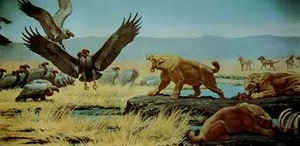Ohio State Invertebrate Fossil
Trilobite

(Isotelus sp.)
Adopted on June 20, 1985.
Two elementary-school classes in Dayton proposed that the Huffman Dam trilobite, (Isotelus sp.,) be made the official State Invertebrate Fossil. While declining to designate only that specific specimen, the legislature instead passed a bill naming the genus Isotelus, and it was signed by the governor on June 20, 1985.
Ohio House Bill 145 designated the trilobite (genus Isotelus) as the official State Invertebrate Fossil of Ohio. With the signing of this bill, Isotelus joined Ohio's other official state symbols, which include the ladybug (insect), red carnation (flower), flint (gemstone), cardinal (bird), white-tail deer (animal), tomato juice (beverage), and of course, the state tree, the buckeye.
Ohio State Invertebrate Fossil: Trilobite

Trilobites are an extinct class of the Phylum Arthropoda, which includes among its living members the horseshoe crab, crabs, lobsters, shrimp, scorpions, spiders, and insects. Trilobites first appeared in the fossil record about 570 million years ago and became extinct about 260 million years ago. Isotelus has had a long and illustrious history in Ohio, in terms of both geologic time and scientific study.
Isotelus is known from rocks of Ordovician age, about 504 to 438 million years ago. In southwestern Ohio, only rocks of Late Ordovician age (450 to 438 million years ago) are exposed. These rocks consist of about 820 feet of comparatively thin, alternating layers of limestones and shales. These beds were deposited as limy mud and clay on the floor of a warm, shallow, tropical sea that covered Ohio during the Ordovician. Trilobites lived in marine environments, where they burrowed in sediment, crawled along the sea floor, or were free swimming. Most trilobites ate mud from the sea floor, whereas others filtered food directly from the water, scavenged, or were predators. They grew by periodically molting their exoskeleton, a hard, outer shell similar in composition to fingernails. Thus, one trilobite could leave behind numerous fossil fragments representing shed exoskeletons. As best as can be determined, the only defense trilobites had was to enroll, much like the pill bug or armadillo of today, thereby enclosing their legs and softer underside within their hard outer exoskeleton.
Perhaps the most famous Isotelus specimen was discovered in 1919 by workmen digging an outlet tunnel during the construction of the Huffman Dam on the Mad River northeast of Dayton. This giant specimen of Isotelus measures 14 ? inches long by 10 ? inches wide. Through the efforts of Arthur E. Morgan, chief engineer of the Miami Conservancy District, the trilobite came into the hands of August F. Foerste, a Dayton area high school teacher and one of Ohio's most renowned and prolific paleontologists. Foerste's research association with the National Museum of Natural History (the Smithsonian Institution) in Washington, D.C., resulted in the specimen being transferred to that institution for permanent display. The Huffman Dam trilobite still occupies a prominent position in the paleontological exhibits at the Smithsonian more than 75 years later and is still one of the largest, complete trilobites of any kind ever collected.
The Ohio Revised Code
The law designating the isotelus as the official Ohio state fossil is found in the Ohio Revised Code, General Provisions, Chapter 5, Section 5.071.
GENERAL PROVISIONS.
CHAPTER 5. STATE INSIGNIA; SEALS; HOLIDAYS.
SECTION 5.071.
The Ohio State Invertebrate Fossil
Ohio State Invertebrate Fossil
Isotelus
[§ 5.07.1] § 5.071 Official state invertebrate fossil.
Isotelus, a genus of extinct marine arthropod of the class trilobita, that lived in the seas that covered Ohio during the ordovician period, about
four hundred forty million years ago, and represented by the largest known complete trilobite, collected at Huffman dam in Montgomery county, is hereby
adopted as the official invertebrate fossil of the state.
History
HISTORY: 141 v H 145. Eff 9-19-85.
Taxonomic Hierarchy: Trilobite
Kingdom: AnimaliaPhylum: Arthropoda
Class: Trilobita
Order: Asaphida
Superfamily: Asaphoidea
Family: Asaphidae
Genus: Isotelus

Some states that lack a "state fossil" have nevertheless singled out a fossil for formal designation such as a state dinosaur, rock, gem or stone.







